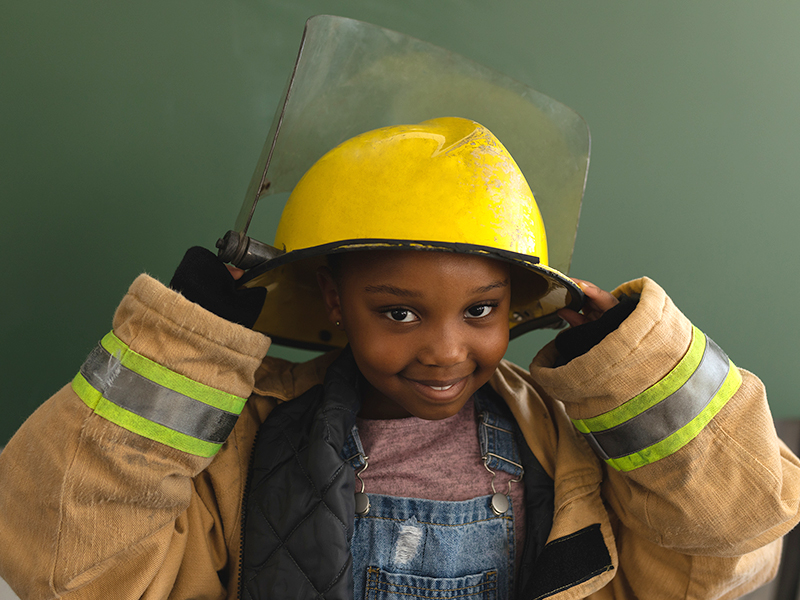When it comes to home disasters, children are most likely to experience a fire. Preparedness and planning save lives, but nearly three-quarters of Americans have never developed or practiced a home fire escape plan.
I know what you are thinking: “The chances of my house catching on fire are remote. House fires only happen on the news. To other people.”
That’s what I thought, too, until my husband and I stood shivering in the snow while firefighters crashed through our burning home and reporters buzzed around.
A brand-new lamp shorted out while we were at work, turning our bedroom into an inferno that blasted out our windows. Energized by gulps of air, it proceeded to lick its way toward the roof.
According to the National Fire Protection Association (NFPA), fires claim as many as 400,000 homes in the U.S. each year. Although we were displaced from our home for several months, we counted our blessings that no one was hurt or died. On average, seven people die each day in house fires across the nation.
Curious youngsters who play with fire are also cause for serious concern. According to the American Red Cross, children under 5 are twice as likely to die in a house fire compared to the rest of the population. Frightened kids who don’t know how to escape or what to do, panic.
Take steps to help keep your kids safe.
Visit the fire department. From the time my boys were toddlers, I’ve taken advantage of organized tours to our local fire department. The firefighters show the kids how they change into their protective gear. I could see why fire-fighters worry about kids hiding from them during a fire. Dressed in their masks and gear in the station, they look alien. But they must look terrifying and monstrous while fearlessly marching through dark smoke and flames searching for scared children and pets.
If you and your family have never been on one of these tours, call your local fire department to schedule one. Encourage other families to join you. You don’t have to be with a school or organization and the tours are free.
Create and practice an escape plan. When my son was in second grade, the teacher assigned the kids to come up with a fire escape plan. Together, we drew a floor plan of our house. Then we walked through it to come up with two ways out of the house in the event of a fire. We ran a drill, crawling through the house to get to the exits and designating a family meet-up spot outdoors. This was a valuable exercise to see how quickly we could get out and if there were any flaws in our design.
Got a two-story home? “Get a ladder,” says Nicole Feltz, an American Family Insurance agent. “It will allow the family and kids to escape if you can’t get down the stairs.” Store the ladders under upstairs beds.
Test your smoke alarms annually. Choose a holiday, anniversary or birthday to make it easier to remember. We tested our smoke alarms while practicing our escape plan. NFPA says that nearly half of fire deaths are prevented simp-ly by having working smoke alarms.
Create a home inventory. Even if no one dies or is injured, going through a fire is traumatic. Walking through the soggy, burned-out shell of our home, with the toxic smell of melted plastic searing our nostrils, was surreal. The days that followed were mind-numbing as we tediously inventoried the sooty remains that mapped our lives.
Inventory your possessions before disaster strikes. Feltz suggests the Dream Vault app to take pictures of the items in your home. File or scan copies of receipts for large ticket items. “If you update a deck, fence or kitchen, take a picture even of the receipt,” Feltz says.
Purchase a fire-proof safe. My husband and I received a fire-proof safe soon after we were married as a Christmas gift. The box seemed like an odd gift to me at the time. But for less than $50, this safe proved priceless, saving us a few headaches. (See the sidebar for the types of documents to store.)
In the end, we were lucky. My husband and I had each other, reliable insurance and many friends offering support. The house was rebuilt, our lives restored and things replaced.
Now that we are parents, our two little risk factors have raised the stakes. I’m not gambling on their safety. To me, that would be like playing with fire – a fire I’m not sure I’d ever recover from.
Documents to store in your fireproof safe:
- Homeowners insurance and your insurance agent’s name and number
- Passports
- Original birth certificates
- Original Social Security cards
- CD or external hard drive of family photos and inventory
- Copies of important legal and financial documents
- Safety deposit box keys if you have a bank deposit box
- List of family physicians, copies of current prescriptions and pharmacy con-tact information
- Bank account information and copies of your credit cards and bank cards to help you access your funds quickly.
Source: Legal Zoom
Quiz
1. What is the leading cause of house fires?
a. Space heaters
b. Cooking
c. Kids playing with matches
2. What do you do if your clothes catch on fire?
a. Run screaming
b. Stop, drop and roll
c. Take your clothes off
3. Where is the best place to hide during a fire?
a. The bathtub
b. A closet
c. Never hide
Answers: 1 B; 2 B; 3 C


